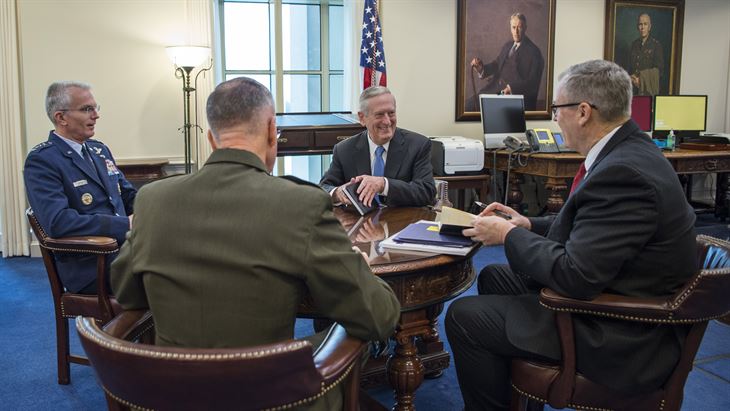‘At War Next Week’: Bob Work On Readiness, Modernization, & COCOMs
Posted on

Robert Work
WASHINGTON: The US can’t afford to modernize its military and increase its size at the same time, said the former deputy secretary of defense , Bob Work. It can’t build up war-ready forces to deter Russia and China while engaging in non-stop operations around the world, the way we have since 1991. If we have to choose – and we do have to, he said – modernization must take priority over growth and warfighting must take priority all other missions.
“When Secretary Mattis came in, he was shocked when he said, ‘ok, what happens if Korea goes up?'” because he got deeply unsatisfactory answers about the readiness of the force, said Work, who was Jim Mattis’s deputy at the time.
“This was one of the greatest moments I had as the deputy secretary of defense,” Work told an audience at SAIS yesterday evening. “Sec. Mattis looked at all of the senior military officers in the department and said, ‘I want you to think and operate every day as though we’re at war next week….You need to be thinking that things can go south in an hurry and we’ll have to respond regardless of the state of our forces.”

Defense Secretary James Mattis at his first meeting at the Pentagon. Robert Work is at the right.
Two Traps
As the White House, Congress, and the Pentagon struggle to restore the US military’s readiness for war, Work said, they must avoid two great traps. First, he said, we can’t let the insatiable demands of the theater combatant commanders (COCOMs) siphon off forces from the vital task of deterring rival nation-states, above all Russia and China. Second, he said, we can’t let well-intentioned enthusiasm to build a bigger force – as President Trump and House Republicans have promised – come at the expense of readiness and modernization for the military we already have.
During the Cold War, Work said, US policymakers had clarity about the military’s missions. Deterring the Soviet Union by standing ready to fight it – primarily with conventional forces in Europe, but with nukes if necessary – was unambiguously number one. Readiness to respond to lesser crises such as Vietnam came second. “Shaping” operations to advance peace, stability, and democracy around the world came a distant third. In the years of US unipolar dominance after the fall of the Berlin Wall, however, those priorities reversed, until shaping become the dominant mission in both official doctrine and operational practice.
So even as Central Command waged two prolonged wars in Afghanistan and Iraq, CENTCOM and other COCOMs kept up an intense pace of operations to take out terrorists, train local partners, respond to disasters, and generally show the flag. In fact, the way the Defense Department works, COCOM commanders could make unlimited demands without paying any of the cost, leaving it to Pentagon planners and the overstretched services to figure out how to meet them.
The result, Work said, has been a terrible erosion of readiness to fight an actual war.

The USS McCain heads for Shanghai after a collision that killed 10 sailors.
Modernization vs. COCOMs
The Japan-based 7th Fleet, for example, was waiving certifications on training to get ships out to sea for “presence” patrols, contributing to two deadly accidents. Maintenance on submarines is badly backlogged, leaving few boats ready to respond in a crisis.
“Cut presence before cutting maintenance, for God’s sake!” fumed Work, a retired Marine and former navy undersecretary. “The US Navy, the greatest navy on the planet, is in big trouble right now because it tried to chase all of the shaping requirements that were levied upon it, rather than just say no.”
It’s worth noting that Trump’s relatively new Navy Secretary, Richard Spencer, has said publicly the Navy should start saying no to missions that come at the expense of readiness. Defense Secretary Mattis has put readiness as priority No. 1 across the board. So there are signs this mindset is taking root in the Trump administration.
Work’s other key argument, however, may be less welcome in Washington. “Before substantially increasing the size of the joint force, I would argue, hone the force we have,” he said. President Trump has promised a larger military, and while the president’s proposed budgets have been modest, House Republicans in particular have been keep to add more troops, ships, and planes. Work argues that’s a mistake, because, in a limited budget, hiring more people and buying more weapons comes at the expense of developing and fielding better weapons.
To deter rising great power rivals, Work argued, the US must invest in a range of key technologies, especially
- artificial intelligence and robotics, a major theme of the Third Offset Strategy he championed as deputy secretary;
- space operations, including offensive warfighting in space, another area Work championed as deputy;
- hypersonics, which operate in realm above the highest-flying aircraft but below the lowest-orbiting satellite, a realm Work says we have unilaterally ceded to China;
- air and missile defense, from short-range battlefield systems (SHORAD) to Patriots;
- cyber and electronic warfare, the ability to dominate the digits on which modern militaries and societies rely;
- cheap-to-operate light attack aircraft so we can reserve high-tech fighters for high-threat missions
- and a new nuclear triad of ICBMs, bombers, and submarines.
All those areas “don’t require a lot of forces,” Work said. “They require a lot of money.”
So where does the money come from? “I do expect an increase in defense spending,” Work said. “I don’t think the increases will be as big as some people hope for or expect.”
“If it turns out that we get no increase in defense, then I can state with absolute certainty that the force structure we have right now is too big for the budgets we have had for the last several years,” Work went on. “As a result, we’ve had to make very serious choices, not buy as many munitions, cut back on maintenance availabilities, not modernize the ground forces.”
“So,” Work concluded, “if it becomes evident we will not get an increase in defense spending, then, in my opinion, we must make the force smaller and make it more capable and ready.”
Subscribe to our newsletter
Promotions, new products and sales. Directly to your inbox.
